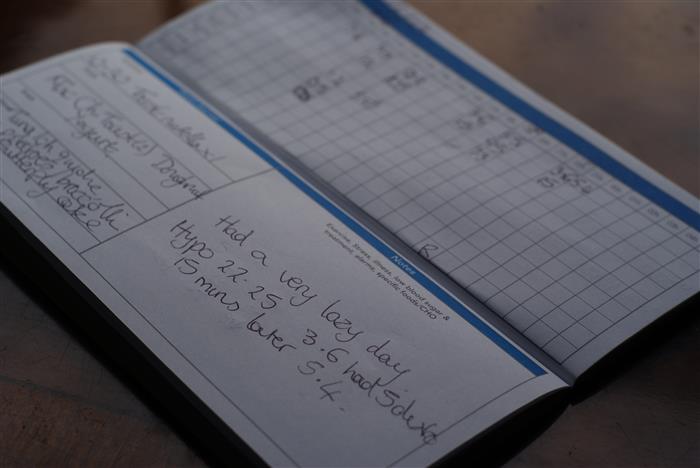Setting the pump up
Going on a pump isn’t just a simple case of plug in and go, it involves a fair bit of work, but nothing insurmountable or problematic, just stuff which needs to be done.
Initially your DSN (diabetes specialist nurse) works out what they believe the best basal profile is for you, doing this by asking lots of questions about lifestyle & food and checking backing weeks of log book entries – that is if you’ve been good and filled in your log book, we hadn’t! So there’s my first tip: make sure you fill in your log book for a few weeks beforehand if you’re not doing it religiously already.
After deciding the profile our DSN read out the values to Amy – during our pump training day last Thursday – she input the values, which brings me nicely on to…
Does your DSN actually need to touch your pump? Ever?
I’d not really thought about this before but at the DRWF event on Saturday Lesley from INPUTDiabetes said something like “Once you’ve got your pump your DSN should never need to touch it, if they do you’ve not received enough training.”
It was a good point and on reflection neither our DSN nor our Animas pump rep has touched Amy’s pump, certainly not to input or change anything, and I’m pretty sure they’ve not touched it at all.
So that’s good then, we’ve been trained correctly.
I suppose it’s oh so easy to hand over your pump to the DSN and get them to change the settings but what do you do when you need to change anything in the future? Would you know how to do it?
In our case Amy is a whizz with things like this so she set up the pump, with me trying to look over her shoulder to make sure they settings were right.
So, for us, not only has the pump not really been touched by the DSN, nor the rep, nor the Doctor, it hasn’t really been touched much by us, the parents.
Filling in the Animas log book
As you’ve probably read I’ve been worried how much my hospital are ok with using Animas as we’re the first in paediatrics in the hospital to have an Animas pump. So it was nice to hear from the DSN who was inspecting the new log book that it was one of the best ones and she’d like us to use it, rather than continue with the Roche one we’d (rarely) been using up to now.
Each day takes up two facing sides, with the top page having columns for each hourly block and rows for readings/values: blood glucose; carb grams; BG bolus (correction doses); Carb Bolus; basal rate; basal rate change; temp basal rate; ketones; set change (tickable).
On the bottom page there’s spaces to write information about food and a big notes area to write notes and things like ‘had a very lazy day’.
A tiring first 48 hours
Our DSN had requested that we test Amy’s blood glucose everything two hours, put the entry into the pump and trust the pump’s suggestion. It seemed a strange request, of course we’d do that, but I guess that some people battle against it and then wonder why their levels are all over the place. I was grateful that it was only 48 hours as a twitter friend of mine, who’s son went on a pump a week ago, has been asked to do it for one week!
These tests were to happen every two hours for 48 hours, including throughout the night so Jane and I divided the shifts with me doing the 10pm, midnight and 6am shifts and Jane taking on the 2am and 4am. This minimised the tiredness levels for both of us, although not by much.
It didn’t seem too tiring initially although I got through most of Friday and Saturday relying on caffeine and much yawning. Luckily Amy managed to almost sleep through all 2am and 4am checks.
From midday Saturday, approximately 48 hours after going on the pump, Amy was taking part in a large choral concert so was without us for many hours. She coped well, still ecstatic about her pump.
Basal/pump reviews and calls from our DSN
Our DSN works Monday to Friday but called us on Saturday in her own time to check how things were going; they were going well.
She called again later that day and again on Sunday.
So far between us we’ve decided that no changes are required to the basal and that we should continue with the current settings.
We’ve got our advanced pump training tomorrow so there may be some changes made then.

 the log book page for 23rd June
the log book page for 23rd June